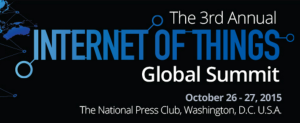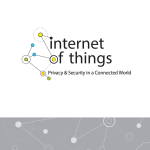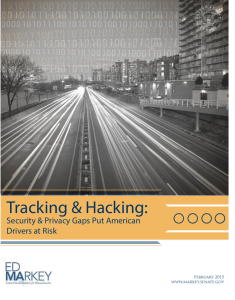 I want to offer you six great reasons — five of them are seated with my wife and me in this photo — why we all should make global warming a primary focus of IoT projects for the foreseeable future.
I want to offer you six great reasons — five of them are seated with my wife and me in this photo — why we all should make global warming a primary focus of IoT projects for the foreseeable future.
There simply is no way to sugar-coat the grim news coming out of the Paris climate talks: even with the most dramatic limits that might be negotiated there, scientists warn we will fall short of the limits in temperature rises needed to avoid global devastation for my grandchildren — and yours.
Fortunately, the Internet of Things can and must be the centerpiece of the drastic changes that we will have to make collectively and individually to cope with this challenge:
- nothing is as crucial to dealing with global warming as building smart cities. Concentrating more of our population in cities, and making them models of efficient transportation and electrical use can not only save us a tidy $22 trillion, but also offset India’s entire carbon emissions. Incredible!
The growing global free citywide IoT data network movement spawned by the Things Network will be essential, because it will transform entire cities into IoT labs, and I’m convinced it will spawn amazing new apps and devices that we can’t even conceive of today.
Developers can play a critical part, building in sensors in any new construction and using new smart building technology such as as Thyssen-Krupp’s new MAX smart elevator systems (which, BTW, can be retrofitted into existing ones!). - Relatedly are the benefits the world will enjoy from the smart grid, made possible through a combination of renewable energy and IoT devices that will allow two-way communication with the utility and much more precise matching of generation and demand. The Pecan Street project in Austin proves smart grid allows quality of life AND greening, Green Mountain Power gets points for leasing Tesla’s new PowerWall batteries so solar homes can store electricity and the utility will cut the need to use dirty “peaking” plants during high demand days.
- We need to reinvent agriculture. No more shipping produce half a world away: instead we need to foster local production, even in our own urban high-rises, as with the innovative Grove Labs system.
- This can lead to a whole new, profitable and sustainable system for the economy and individual companies: the circular economy, in which sensor-laden products are either upgraded or recovered at the end of their usable lives, and manufacturing achieves unprecedented efficiency and precision. I’m proud that I work part-time for the world’s most profitable company, which shows that environmental leadership is a key part of profitability.
- You and I can and must play a direct part. I love the way my WeMo sockets have allowed my wife and me to find a peaceful resolution to our differences about when the lights should go on, but I’m equally happy that they allow me to manage my lights from miles away, shutting them off if I left the lights on, and doing my little part to reduce electricity demands. I’m waiting a little while for lower cost smart thermostats: 3 Nests @ $150 each after a utility rebate is still a little much for me, but any new home should include them. Even better, why not play an active part in highlighting problems, as the Londoners who planted air quality sensors at their homes around Heathrow, documenting excessive emissions, or those in Louisville who had GPS devices attached to their asthma inhalers to identify air pollution hotspots (hey, Mitch McConnell: it’s ’cause of burning coal. Time to give up and create alternative jobs instead of mining!)
- The IoT’s ability to link sensors planted everywhere with advanced big data analytics, are also crucial to understanding the threat:
“Perhaps one of the most ambitious projects that employ big data to study the environment is Microsoft’s Madingley, which is being developed with the intention of creating a simulation of all life on Earth. The project already provides a working simulation of the global carbon cycle, and it is hoped that, eventually, everything from deforestation to animal migration, pollution, and overfishing will be modeled in a real-time “virtual biosphere.” Just a few years ago, the idea of a simulation of the entire planet’s ecosphere would have seemed like ridiculous, pie-in-the-sky thinking. But today it’s something into which one of the world’s biggest companies is pouring serious money.”
Let me leave you with a laundry list of potential IoT uses to reduce global warming compiled by Cisco’s Dr. Rick Huijbregts:
- Urban mobility “apps” predict how we can move from A to B in a city in the most environmental friendly manner. Real time data is collected from all modes of city transportation.
- Using solar energy to power IT networks that in turn power heating, cooling and lighting. Consequently, reduce AC/DC conversions and avoid 70% electricity loss.
- IPbased, and POE (Power of Ethernet) LED lighting in buildings reduced energy by 50% because of LED and another 50% because of control and automation.
- Sensors (Internet of Things) record environmental highs and lows, as well as energy consumption. Data analytics allow us to respond in realtime and curtail consumption.
- Real time insight in energy behaviour and consumption can turn into actionable reduction. 10% of energy reduction can be achieved by behavioural change triggered by simple awareness and education.
- Working from home while being connected as if one were in the office (TelePresence, Cisco Spark, WebEx, just to name a few networked collaboration tools) takes cars off the road.
- Grid modernization by adding communication networks to the electrical grid to allow for capacity and demand management.
- Planning, optimizing, and redirecting transportation logistics based on algorithms, realtime weather and traffic data, and streamlined and JIT shipment and delivery schedules.
These are all great challenges and offer the potential for highly profitable IoT solutions. For the sake of my six grandchildren, let’s get going!




